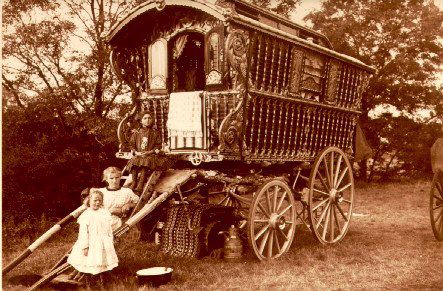THE GYPSY VARDO

The 'Reading' type of waggon - 1921
The Romany Vardo of the English Gypsies
The Romany Gypsies seem to have taken to the waggon or vardo about the middle of the nineteenth century. George Borrow writing in his Romano Lavo-Lil, which he finished in 1873, says that the caravans were not very numerous on the roads at this stage and it is true that many Gypsies continued to live in bender tents right up to the end of the century. The Gypsy style of waggon was certainly in vogue however, even as early as 1840 when Charles Dickens described Mrs. Jarley's van with its bed, stove, closet or larder and several chests (Old Curiosity Shop, ch. xxvii):
One half of it... was carpeted, and so partitioned off at the further end as to accommodate a sleeping-place, constructed after the fashion of a berth on board ship, which was shaded, like the windows, with fair white curtains... The other half served for a kitchen, and was fitted up with a stove whose small chimney passed through the roof. It also held a closet or larder, several chests, a great pitcher of water, and a few cooking-utensils and articles of crockery. These latter necessaries hung upon the walls, which in that portion of the establishment devoted to the lady of the caravan, were ornamented with such gayer and lighter decorations as a triangle and a couple of well-thumbed tambourines
There are five main types of Gypsy and hawkers' living-waggons. These include the Bow-topped Waggon, two versions of which were the Spindle-sided Potter's Four-wheeled Cart and the Two-wheeled Sleeping Cart which was used by the Staffordshire salt-hawkers. Other types included the the Cottage-shaped or Ledge Waggon, the Brush Waggon and the Straight-sided Waggon which was also known as the Showman's Waggon. It was probably in the Reading Waggon or the old type of Gypsy vardo, however, that the Gypsy waggon reached its highest and most characteristic form. This was a waggon with large wheels running outside the body of the van, which slopes outwards considerably towards the eaves. During the heyday of the vardo the family most widely reputed as builders were the Duntons of Reading. The vardo became the Gypsy woman's most coveted possession, the paramount domestic status symbol. As Rodney Smith, better known as 'Gipsy' Smith, the evangelist, says in his autobiography describing Gypsy life in the late 1800's:
The young gipsy couple started their married life by purchasing a waggon. This costs anywhere from £40 to £150 and is obtained from a gorgio waggon-builder. Oddly enough, the gipsies never learn the trade of making their own waggons. The waggons are very warm and very strong, and last a great many years. The young husband is, of course, the manufacturer of the goods, and his wife the seller. When she leaves the waggon in the morning to go her rounds she arranges with her husband where the waggon shall be placed at night, and thither she betakes herself when her day's toil is over. In the course of the day she may have walked from fifteen to twenty miles. If the husband has been refused permission to stand his waggon on the arranged spot and has had to move on, he lets his wife know where he is going by leaving behind him a track of grass.
After 1920 the travelling showmen who had toured the country in their Burton waggons turned over their pulling power from horse and steam to petrol and oil and by the 1930's very few of them travelled in the old way. The Romanies still clung to their vardos, although the economics of their way of life was in upheaval due to the contraction in the horse-trading industry and the changes from their traditional crafts to scrap-dealing and tarmacing. While most Gypsies have gone over to trucks and trailers and despite the fact that only about one per cent of the traveller population still live in horse-drawn waggons, the tradition of the vardo is still very much alive as can be witnessed on an annual basis at the large Gypsy fair in the town of Appleby, Cumbria, every summer.